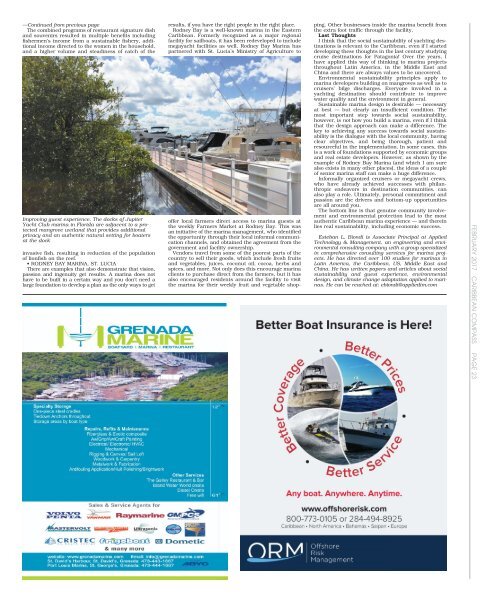Caribbean Compass Yachting Magazine February 2017
Welcome to Caribbean Compass, the most widely-read boating publication in the Caribbean! THE MOST NEWS YOU CAN USE - feature articles on cruising destinations, regattas, environment, events...
Welcome to Caribbean Compass, the most widely-read boating publication in the Caribbean! THE MOST NEWS YOU CAN USE - feature articles on cruising destinations, regattas, environment, events...
Create successful ePaper yourself
Turn your PDF publications into a flip-book with our unique Google optimized e-Paper software.
— Continued from previous page<br />
The combined programs of restaurant signature dish<br />
and souvenirs resulted in multiple benefits including<br />
fishermen’s income from a sustainable fishery, additional<br />
income directed to the women in the household,<br />
and a higher volume and steadiness of catch of the<br />
Improving guest experience. The docks of Jupiter<br />
Yacht Club marina in Florida are adjacent to a protected<br />
mangrove wetland that provides additional<br />
privacy and an authentic natural setting for boaters<br />
at the dock<br />
invasive fish, resulting in reduction of the population<br />
of lionfish on the reef.<br />
• RODNEY BAY MARINA, ST. LUCIA<br />
There are examples that also demonstrate that vision,<br />
passion and ingenuity get results. A marina does not<br />
have to be built in a certain way and you don’t need a<br />
large foundation to develop a plan as the only ways to get<br />
results, if you have the right people in the right place.<br />
Rodney Bay is a well-known marina in the Eastern<br />
<strong>Caribbean</strong>. Formerly recognized as a major regional<br />
facility for sailboats, it has been redeveloped to include<br />
megayacht facilities as well. Rodney Bay Marina has<br />
partnered with St. Lucia’s Ministry of Agriculture to<br />
offer local farmers direct access to marina guests at<br />
the weekly Farmers Market at Rodney Bay. This was<br />
an initiative of the marina management, who identified<br />
the opportunity through their local informal communication<br />
channels, and obtained the agreement from the<br />
government and facility ownership.<br />
Vendors travel from some of the poorest parts of the<br />
country to sell their goods, which include fresh fruits<br />
and vegetables, juices, coconut oil, cocoa, herbs and<br />
spices, and more. Not only does this encourage marina<br />
clients to purchase direct from the farmers, but it has<br />
also encouraged residents around the facility to visit<br />
the marina for their weekly fruit and vegetable shopping.<br />
Other businesses inside the marina benefit from<br />
the extra foot traffic through the facility.<br />
Last Thoughts<br />
I think that the social sustainability of yachting destinations<br />
is relevant to the <strong>Caribbean</strong>, even if I started<br />
developing these thoughts in the last century studying<br />
cruise destinations for Patagonia! Over the years, I<br />
have applied this way of thinking to marina projects<br />
throughout Latin America, in the Middle East and<br />
China and there are always values to be uncovered.<br />
Environmental sustainability principles apply to<br />
marina developers building on mangroves as well as to<br />
cruisers’ bilge discharges. Everyone involved in a<br />
yachting destination should contribute to improve<br />
water quality and the environment in general.<br />
Sustainable marina design is desirable — necessary<br />
at best — but clearly an insufficient condition. The<br />
most important step towards social sustainability,<br />
however, is not how you build a marina, even if I think<br />
that the design approach can make a difference. The<br />
key to achieving any success towards social sustainability<br />
is the dialogue with the local community, having<br />
clear objectives, and being thorough, patient and<br />
resourceful in the implementation. In some cases, this<br />
is a work of foundations supported by economic groups<br />
and real estate developers. However, as shown by the<br />
example of Rodney Bay Marina (and which I am sure<br />
also exists in many other places), the ideas of a couple<br />
of senior marina staff can make a huge difference.<br />
Informally organized cruisers or megayacht crews,<br />
who have already achieved successes with philanthropic<br />
endeavors in destination communities, can<br />
also play a role. Ultimately, personal commitment and<br />
passion are the drivers and bottom-up opportunities<br />
are all around you.<br />
The bottom line is that genuine community involvement<br />
and environmental protection lead to the most<br />
authentic <strong>Caribbean</strong> marina experience — and therein<br />
lies real sustainability, including economic success.<br />
Esteban L. Biondi is Associate Principal at Applied<br />
Technology & Management, an engineering and environmental<br />
consulting company with a group specialized<br />
in comprehensive consulting services for marina projects.<br />
He has directed over 100 studies for marinas in<br />
Latin America, the <strong>Caribbean</strong>, US, Middle East and<br />
China. He has written papers and articles about social<br />
sustainability and guest experience, environmental<br />
design, and climate change adaptation applied to marinas.<br />
He can be reached at: ebiondi@appliedtm.com<br />
FEBRUARY <strong>2017</strong> CARIBBEAN COMPASS PAGE 23


















